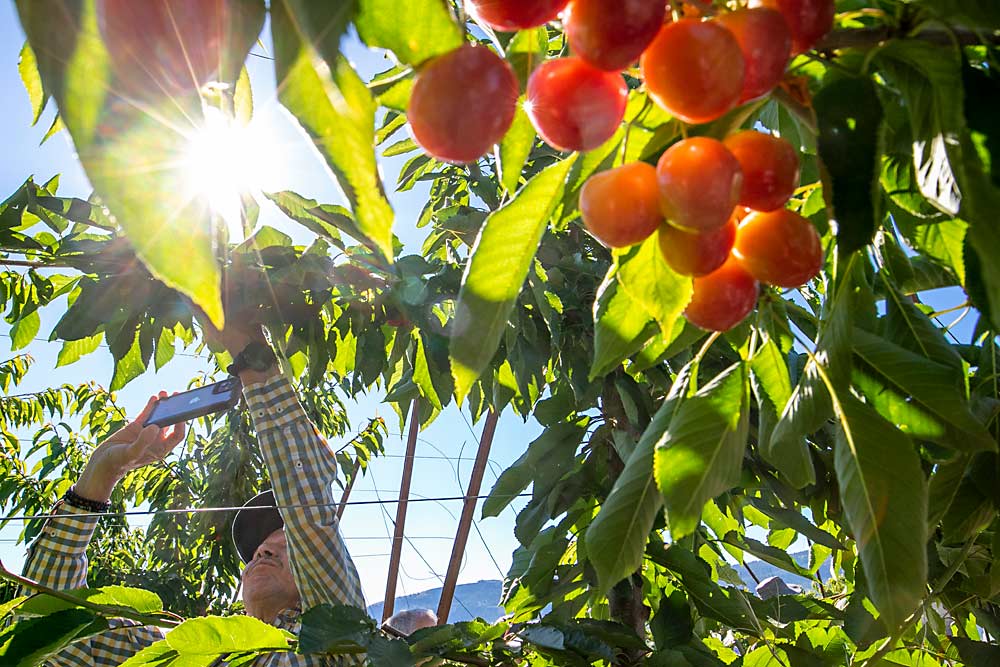
Washington’s cherry season stretches from June through early September, following the topography from south to north through Central Washington, with some of the latest fruit ripening near the Canadian border and at high elevations overlooking the Columbia River above Wenatchee.
In July, the International Fruit Tree Association toured both extremes of Washington’s cherry production, from early Coral Champagne orchards outside Pasco in the southern Columbia Basin — picked weeks before the tour arrived — to Sweetheart and Staccato orchards growing in the footprint of mountain pine forests that were more than a month from harvest.
As the nation’s leading sweet cherry producing state, Washington’s 2,500-plus growers anchor the Pacific Northwest region, which has collectively harvested an average of 22 million boxes in recent years. This year, however, a cold spring cut that production almost in half before growers faced rain, hail and heat during harvest. Despite the difficult season, growers at every tour stop discussed their pursuit of higher density and higher fruit quality achieved by matching the variety with the right rootstock and training system.
Blush without bruises
Grower Joe Wiggs hosted the tour at two of his orchards in the Wenatchee Heights area, overlooking the city. In this area, the growing season is so short that cherries are the top crop, Wiggs said, although he does farm a small block of Honeycrisp to balance the risk of cherries.
The first block was a Skylar Rae planting on Gisela 6 rootstocks, planted at 8 feet by 12 feet in 2016. Skylar Rae is a proprietary blush cherry that ripens about a week ahead of Rainier, and it’s named for the late daughter of the growers, Kim and Troy Toftness, who found the chance cherry in 2005.
Wiggs said he trains all his blush cherries to a V-trellis, because tying down the branches reduces wind damage and helps his pickers harvest the easily bruised fruit. But, he said, he’s had trouble retaining enough workers to do the training needed — which can boost the production of a block by 3 to 5 tons an acre.
“To me, one of the most important things you can do for profitability in a cherry orchard is tree training. It’s pruning and training and branch manipulation,” Wiggs said. “We’re kind of halfway there. We don’t have the labor we need to do a fine job of tree training and supporting all these branches.”
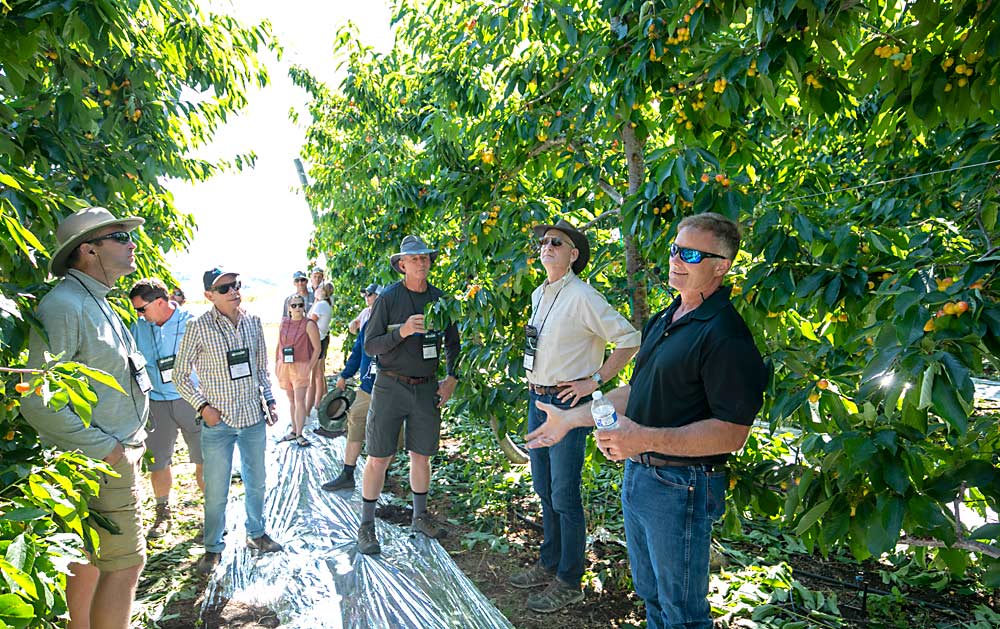
On precocious Gisela 6 roots, there’s also a challenge of controlling crop load, which Wiggs discussed with the group. Tour host Jeff Cleveringa of Starr Ranch Growers recommended heading cuts on all the 1-year-old shoots during the dormant season.
“Everything you don’t head all becomes fruit,” he said. “Almost every new shoot that you’re going to leave needs a heading cut on it to keep it vigorous and growing. Or else it all just becomes fruit, fruit, fruit, and then you don’t have the leaf surface to support it and the tree diminishes.”
At his second orchard, a 10-year-old Rainier block on Gisela 6 trained in a similar style, Wiggs had rolled out reflective fabric and done some summer pruning to try to boost color. That’s always a gamble, since at his elevation, he’s picking blush cherries in the hottest part of the year, Wiggs said. He has to find the right balance to develop color without cooking the fruit.
Ideally, to maximize quality, the orchard should crop 7 or 8 tons to the acre, Wiggs said, but this year he has about 10. “I didn’t think I was going to have a crop in here, with the weather,” he said. “Now, you can see maybe I should have thinned some.”
Grower Tim Welsh of Columbia Fruit said that in a similar block, his crews use string thinners to keep the crop at 6 to 8 tons per acre, to maximize quality and size.
Density-driven
While Wiggs opted for precocious rootstock to boost his productivity, grower Denny Hayden decided to put a precocious variety, Coral Champagne, onto Mazzard roots to help control the crop load. Hayden farms in one of the state’s earlier districts, just north of Pasco, and he likes the early cultivar as part of his strategy to quickly get in and out of the cherry market. He invited the tour to see the 2017 and 2018 plantings, spaced at 8 feet by 12 feet.
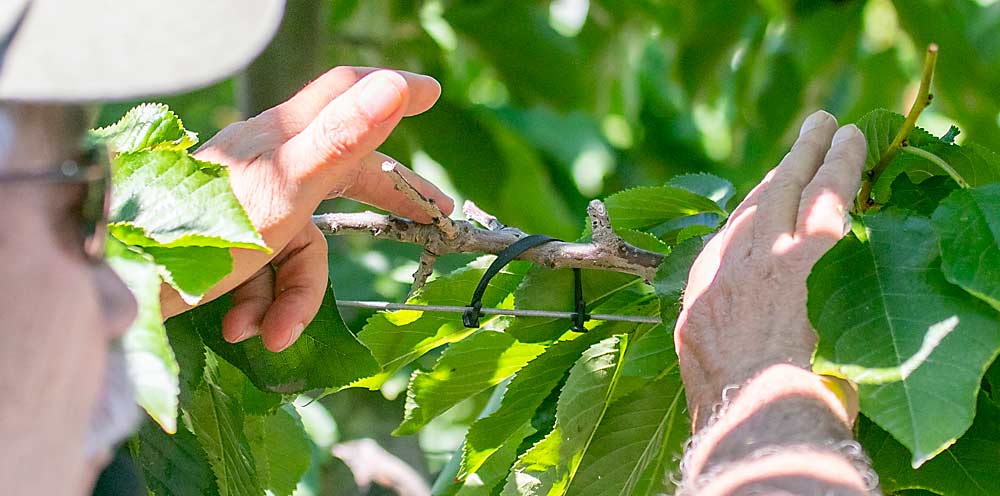
“That’s pretty dense for Mazzard roots,” Hayden said, adding that the formal, V-trellis system with seven wires should control vigor in the limbs by bending them down to the wire. “If you get it flat, it will fruit.”
As for renewal, during the dormant season he prunes back the ends of each branch, “to pull the vigor through the branches we tie down,” he said.
The planar approach should also allow for use of platforms for pruning and training, as well as string thinning if necessary — though the unusually cold, wet spring meant he only had half a crop this year. The system should support 10 to 12 tons per acre, he said.
He also showed the group a trial planting of Coral Champagne on the dwarfing rootstocks developed by Michigan State University: Cass, Clare, Clinton, Crawford and Lake. The trees were planted into the same V-trellis system but spaced just 18 inches apart.
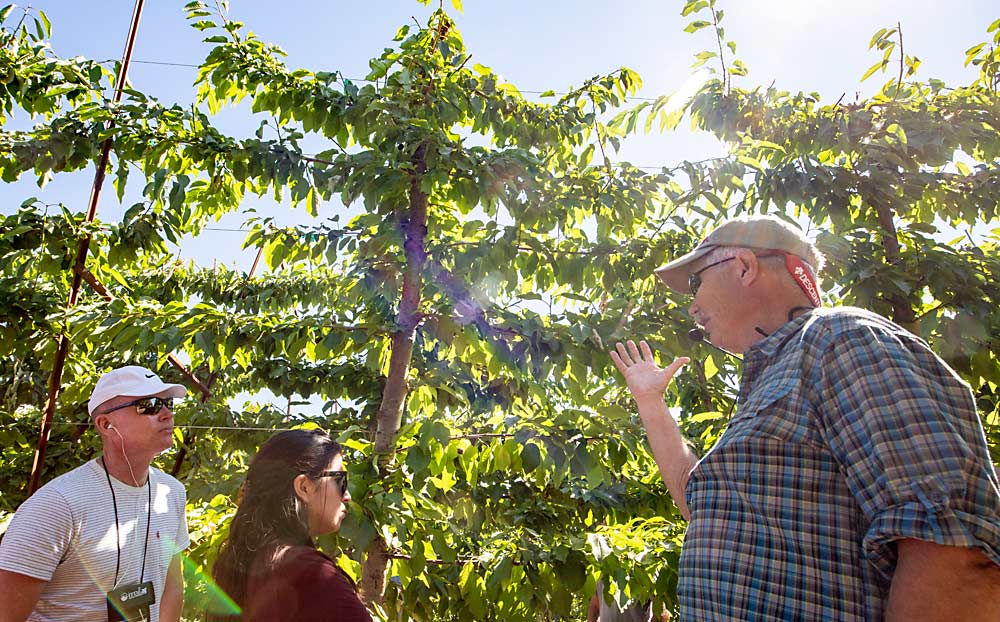
The biggest takeaway is that the rootstocks definitely deliver size control, Hayden said, but they don’t seem well-suited to his training system.
“Clinton might adapt to the wires, but the rest would be better in a super spindle where they could keep those fruiting structures short,” he said.
For the rest of the block, Hayden used the Coral-on-Mazzard combination, but trained with two leaders, one on each side of the V-trellis, to “soak up that vigor,” he said.
It seems to be working well. The early training takes some work, Hayden said, but then it’s just a matter of getting enough light into the block to drive renewal.
The art of elevation
Grower Kyle Mathison introduced himself to the tour with a story about how his father founded the Stemilt Growers packing shed in the 1960s, to give growers on the ridge southeast of Wenatchee — known as Stemilt Hill — more control over their fruit. Today, he has orchards from the bottom of the hill, at 1,600 feet in elevation, to the top, where his highest orchard to date grows at 3,400 feet. His variety mix and horticulture has evolved with the gains in elevation.

Mathison said he learned this from his father: “You’ve got to separate yourself from the commodity, or you’ll never make any money.”
That’s what he has done by aiming to diversify his variety mix, targeting fruit earlier and later than the bulk of Washington’s production.
“I don’t have a Bing tree left. It’s a great cherry, but I can’t afford to grow them,” Mathison said. Many of his neighbors, however, did not “retool fast enough” and couldn’t afford to replant when little cherry virus hit the area almost a decade ago. He has since bought the land from about a dozen neighbors, and after burning the trees and fumigating to prevent disease spread, he replanted into self-fertile varieties with higher yields and better marketing windows.
“My three loves are Skeena, since we don’t get a lot of rain up here, Staccato and Glory,” he said of growing at higher elevations. Back down at the bottom of the hill, he prefers earlier cherries such as Coral Champagne and Black Pearl. “You have to learn to dance with every variety.”
Mathison’s rootstock preferences also follow the terrain; Mazzard provides the engine needed to grow in the shorter season at higher elevation. He also uses compost — made onsite with a blend of yard waste, manure and culled apples — at 12 tons per acre, as well as amendments such as fish fertilizer, molasses and seaweed to get the “soil biology cranking” in the spring and to help the trees replenish carbohydrates after harvest.
“The trees don’t have time to build those carbohydrates for next year, if we pick the first week in September and get frost the last week,” Mathison said. “That backflow is the antifreeze in these trees.”
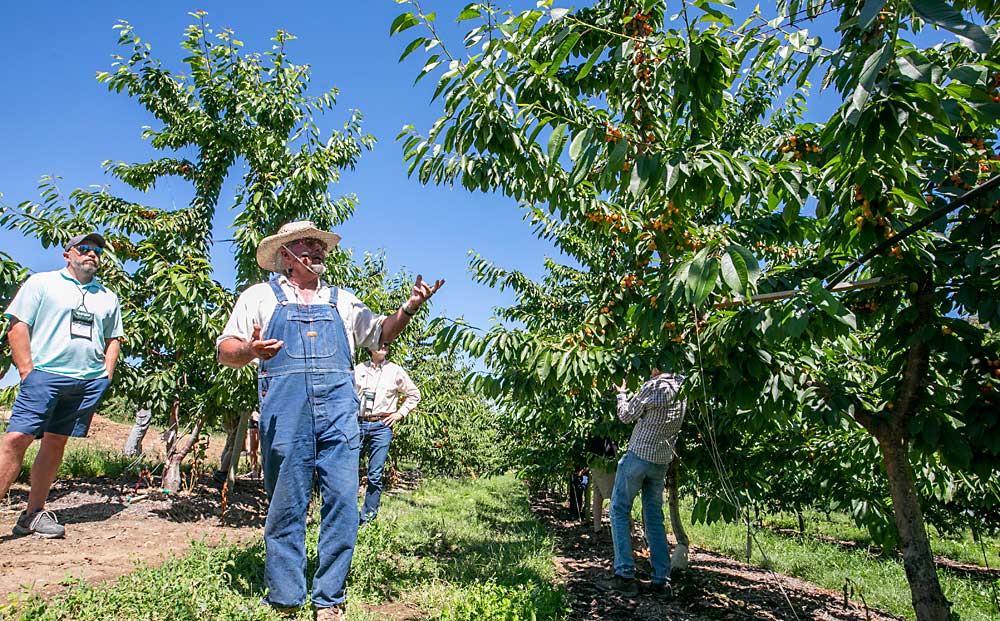
Mathison talked about his approach to crop load management in a fourth-leaf block of Staccato on Mazzard, trained with two leaders, planted at 7 feet by 4 feet. He uses lime sulfur and fish oil to bloom thin if needed, targeting about 75 buds per linear branch foot, which results in about 25 cherries per foot.
“If we have 400 blooms per foot, we have a big problem,” he said. “When they have a heavy crop, it just sucks the life out of them.”
Each variety has its own “trick plays,” Mathison said, such as favoring a June prune in Staccato to devitalize the trees and using string to pull the limbs down into vertical positions to encourage fruitfulness.
He has embraced a lot of experiments over the years, he told the tour, “and when you try new things, you are going to have some ugly children,” Mathison said. But this block showcased what’s working. “I like to see a young orchard grow and produce. This is what gets me excited.” •
—by Kate Prengaman

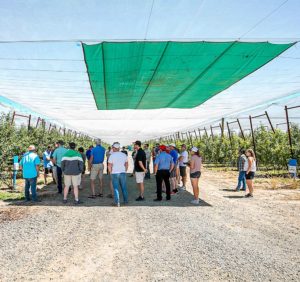
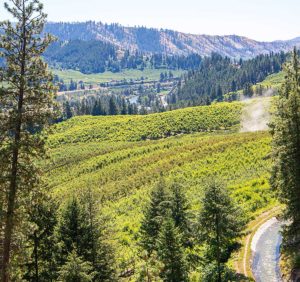





Leave A Comment